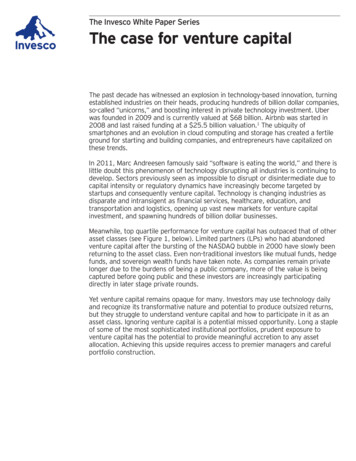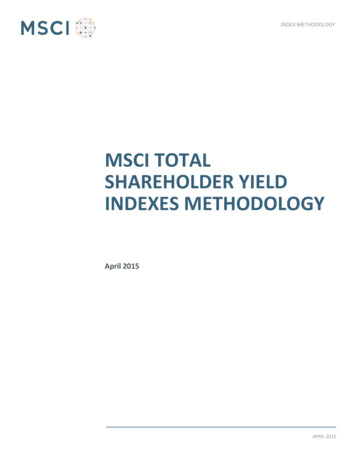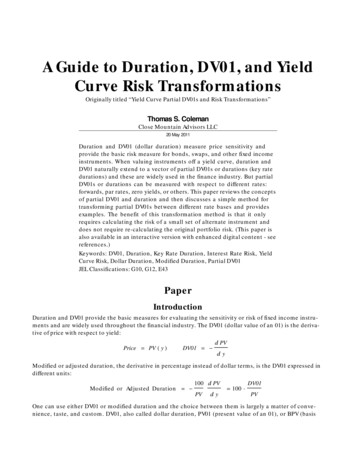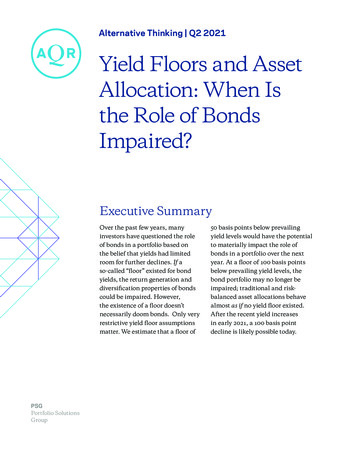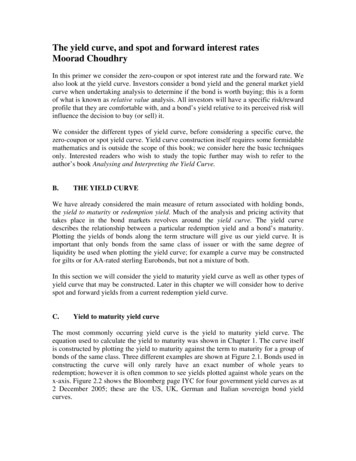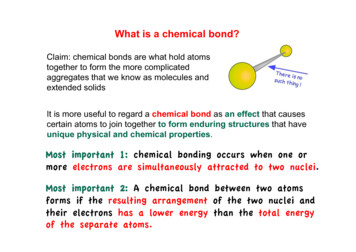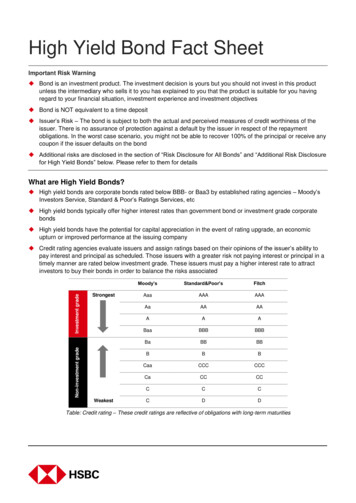
Transcription
High Yield Bond Fact SheetImportant Risk Warning Bond is an investment product. The investment decision is yours but you should not invest in this productunless the intermediary who sells it to you has explained to you that the product is suitable for you havingregard to your financial situation, investment experience and investment objectives Bond is NOT equivalent to a time deposit Issuer’s Risk – The bond is subject to both the actual and perceived measures of credit worthiness of theissuer. There is no assurance of protection against a default by the issuer in respect of the repaymentobligations. In the worst case scenario, you might not be able to recover 100% of the principal or receive anycoupon if the issuer defaults on the bond Additional risks are disclosed in the section of “Risk Disclosure for All Bonds” and “Additional Risk Disclosurefor High Yield Bonds” below. Please refer to them for detailsWhat are High Yield Bonds? High yield bonds are corporate bonds rated below BBB- or Baa3 by established rating agencies – Moody’sInvestors Service, Standard & Poor’s Ratings Services, etc High yield bonds typically offer higher interest rates than government bond or investment grade corporatebonds High yield bonds have the potential for capital appreciation in the event of rating upgrade, an economicupturn or improved performance at the issuing companyStrongestNon-investment gradeInvestment grade Credit rating agencies evaluate issuers and assign ratings based on their opinions of the issuer’s ability topay interest and principal as scheduled. Those issuers with a greater risk not paying interest or principal in atimely manner are rated below investment grade. These issuers must pay a higher interest rate to attractinvestors to buy their bonds in order to balance the risks CCCDDTable: Credit rating – These credit ratings are reflective of obligations with long-term maturities
Who issues High Yield Bonds? Emerging or start-up companies that have not yet achieved the operational history, the size or the capitalstrength required to receive an investment-grade rating Companies seeking relatively higher leverage to stimulate growth, who may be rated non-investment gradeby credit rating agencies. This may be large or small companiesWhat are the benefits for investing in High Yield Bonds? In summary, high yield bonds play an important role in a portfolio, enhancing return potential while improvingdiversification, particularly due to their low correlation to investment grade bonds. High yield bonds can besimilar to equities in that they tend to be heavily influenced by developments in the issuer, but the incomeprovided by high yield bonds and their senior placement in the capital structure help make high yield bondsattractive investment, given the higher degree of associated risks (please read carefully the sections on “RiskDisclosure for All Bonds” and “Additional Risk Disclosure for High Yield Bonds”) Enhanced regular income – High yield bonds usually offer higher yields than government bonds and manyinvestment grade corporate bonds. The yields vary depending on the economic climate, generally risingduring downturns when default risk also rises Portfolio risk diversification – High yield bonds are often considered a separate asset class, involvingdifferent characteristics from those of other securities. High yield bonds can help investors spread assetsacross different segments of the financial market, reducing risk concentration in any one asset class in awell-diversified portfolio Potential capital appreciation – Positive events in the economy, industry or issuing company canpotentially reward investors with increases in high yield bond’s price. These events include ratings upgrades,improved earnings reports, mergers or acquisitions, positive product developments or market-related events Relative security over equities investment – If an issuer is liquidated, bondholders usually have priorityover stockholders in an issuer’s capital structure and are more likely to receive payment. Bondholders of highyield bond are entitled to an issuer’s assets ahead of preferred or common stockholdersWhy don’t I just stay with investment grade bonds, which have relatively lower risks? High yield bonds may offer some advantages over investment grade bonds, depending on the marketconditions, but with higher degree of associated risks (please read carefully the sections on “Risk Disclosurefor All Bonds” and “Additional Risk Disclosure for High Yield Bonds”). High yield bonds offer: A higher rate of regular interest income; Price volatility provides more trading opportunities if the market liquidity is favorable; Potential for capital appreciation if the debt is upgraded by one of the credit rating agencies, which could be moreprofound in high yield bonds, especially if a bond is upgraded to investment gradePercentage change (Volatility)Percentage change in bond pricesInvestment Grade BondsHigh Yield BondsTimeFigure: Price volatility is typically higher for high yield bonds as compared to investment grade bondsIssued by The Hongkong and Shanghai Banking Corporation Limited2
Why is it a good time to invest in High Yield Bonds amid equity market uncertainty? Relative to the potential volatility of equities in the short term, bonds in general are evaluated in the mediumand long term investment horizon. While equities prices may gyrate, bond yields are in effect ‘locked in’ whenheld to maturity as long as there is no issuer default event While the volatility of other lower yielding investment may be more manageable, investors may have to giveup some return when investing in low yield investment Not only will bonds improve risk/returns ratio and diversify portfolio, by employing a buy & hold strategy, youwill receive a stable coupon payout and your capital in full at maturity as long as there is no issuer defaultevent. For equities, the payout ratio is relatively unstable due to fluctuating equity prices Investors should be aware of the risks associated with any investment products in any market environment Under uncertain market condition, investors should consider whether high yield bonds are suitable for themin light of their financial circumstances, investment objectives, and risk profilesHow do High Yield Bond investors manage risks? High Yield Bond investment comes with certain risks, there are techniques practiced by investors to managerisks Diversify across issuers and industry segments – Investors should not put all their assets in one highyield bond. Spreading investment among several issuers and industries can help reduce the risk of pricedeclines or defaults caused by industry-specific events Adjust portfolios over economic and market cycles – One of the best times to own high yield bonds isduring the expansion phase of an economic cycle, when financial measures are increasing along withconsumer confidence Monitor rating agencies – Follow the publications of the rating agencies, which may indicate advancewarnings of market difficulties. Prior to downgrading the rating of an issuer, agencies often place thecompany on a “creditwatch” list Monitor company and industry news – Investors should follow an industry or an issuer closely – just asinvestors would follow equities – to help anticipate factors that may impact the credit rating or the price of abondIssued by The Hongkong and Shanghai Banking Corporation Limited3
Risks disclosure for all bonds Bonds are mainly for medium to long term investment, not for short term speculation. You should beprepared to invest your funds in bonds for the full investment tenor; you could lose part or all of yourinvestment if you choose to sell your bonds prior to maturity It is the issuer to pay interest and repay principal of bonds. If the issuer defaults, the holder of bonds may notbe able to receive back the interest and principal. The holder of bonds bears the credit risk of the issuer andhas no recourse to HSBC unless HSBC is the issuer itself Indicative bond prices are available and bond prices do fluctuate when market changes. Factors affectingmarket price of bonds include, and are not limited to, fluctuations in interest rates, credit spreads, andliquidity premiums. The fluctuation in yield generally has a greater effect on prices of longer tenor bonds.There is an inherent risk that losses may be incurred rather than profit made as a result of buying and sellingbonds If you wish to sell the bonds purchased through HSBC, HSBC may repurchase them based on the prevailingmarket price under normal market circumstances, but the buying price may differ from the original sellingprice due to changes in market conditions There may be exchange rate risks if you choose to convert payments made on the bonds to your homecurrency The secondary market for bonds may not provide significant liquidity or may trade at prices based on theprevailing market conditions and may not be in line with the expectations of the bond holders If a bond is early redeemed, you may not be able to enjoy the same rates of return when you re-invest thefunds in other investmentsAdditional risk disclosure for High Yield Bonds In general, high yield bonds are corporate bonds rated below BBB- or Baa3 by established ratingagencies – Moody’s Investors Service, Standard & Poor’s Ratings Services, etc or equivalent creditquality but unrated. While high yield bonds bear a higher yield opportunity than investment grade bonds,they present greater risks with respect to liquidity, volatility and non-payment of principal andinterest. They incur greater degree of credit risk relative to many other fixed income securities Default Risk – Defaults occur when a company fails to pay an interest or principal payment to a debt holderas scheduled and as specified in the legal agreements. The risk of default on principal or interest, or both, isgreater for high yield bonds than for investment-grade bonds due to higher credit risk of the high yield bondissuer and lower priority of claim by the high yield bond holders. Many high yield issues are cross borderissues (eg Chinese property developers) which have no recovery history for offshore investors reclaimingrights domestically. Therefore, in case of default, the time required for claim on corporate assets in aliquidation distribution may be longer than the investment graded bonds due to lower priority of claim and thedomestic restrictions on the high yield bond holders’ claim rights Downgrade risk – Downgrades result when rating agencies lower their rating on a bond; for example, achange by Standard & Poor’s from a BB to a B rating. Downgrades are usually accompanied by bond pricedeclines. In some cases, the market anticipates downgrades by bidding down prices prior to the actual ratingagency announcement. Before bonds are downgraded, agencies often place them on a “creditwatch” status,which also tends to cause price declines Liquidity risk – Liquidity refers to the investor’s ability to sell a bond quickly and at an efficient price, asreflected in the bid-ask spread. A difference may exist between the prices buyers are bidding and the pricessellers are asking. For largely and actively traded bond, the gap is often smaller, producing greater liquidity.However, the gap is larger for less actively traded bonds which results in a lower liquidity. High yield bondscan sometimes be less liquid than investment-grade bonds, depending on the issuer and the marketconditions at any given time. If the bonds are unlisted, secondary market trading is likely to be furtherrestricted than if they were listed Economic risk – Economic risk describes the vulnerability of a bond to downturns in the economy. Virtuallyall types of high yield bonds are vulnerable to economic risk. In recessions, high yield bonds typically losemore principal value than investment-grade bondsIssued by The Hongkong and Shanghai Banking Corporation Limited4
Volatility risk – Market value of unrated or non-investment grade bonds tend to be more sensitive todevelopments involving the issuer and to changes in economic conditions, and thus have greater pricevolatility than investment graded bonds Company and industry “event” risk – A variety of pitfalls can affect a company’s ability to repay its debtobligations on time. These include poor management, changes in management, failure to anticipate shifts inthe company’s markets, rising costs of raw materials, regulations and new competition. Events that adverselyaffect a whole industry can have a blanket effect on the bonds of its members Concentration risk – Please be aware the concentration risk of investing in bonds issued by the sameissuer or companies by the same group. A degrading of any of the group company’s credit rating mayexpose the whole group to contagion risk. Please be also aware the risk of over concentrating investment inthe high risk investment products There are investment risks involved in buying High Yield Bonds. Before applying for any of the HighYield Bonds, you should consider whether the High Yield Bonds are suitable for you in light of yourown financial circumstances and investment objectivesRemarks:The contents of this document are only for general reference.Making available this document or any marketing materials or any market or product information to you shall not, by itself,constitute solicitation of the sale or recommendation of any product. If you wish to receive solicitation or recommendationfrom us, please contact us and, where relevant, go through our suitability assessment before transacting.The contents of this document have not been reviewed by any regulatory authority in Hong Kong. You are advised to exercisecaution before investing in this product. You should not invest in this product based on this document alone. If you are in anydoubt, you should obtain independent professional advice.Issued by The Hongkong and Shanghai Banking Corporation Limited5
greater for high yield bonds than for investment-grade bonds due to higher credit risk of the high yield bond issuer and lower priority of claim by the high yield bond holders. Many high yield issues are cross border issues (eg Chinese property developers) which have no recovery history for offshore investors reclaiming rights domestically.
